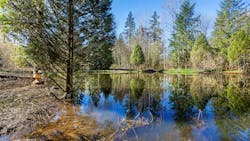Stormwater is a resource … no, really, it is!
A mission of the National Municipal Stormwater Alliance (NMSA) is to promote stormwater as a resource and that investments in stormwater infrastructure should be valued as one would value investments in a precious nonrenewable resource such as gold. To place a value on a resource requires some understanding of the amount available for use. The Pacific Institute, teamed with 2NDNature Software, recently released a report that outlined a GIS-based analysis that found a national estimate of the total annual stormwater capture and use (SCU) potential as being nearly 60 million acre-feet per year. This amount is greater than the estimated potential for wastewater reuse and more than the total urban water use in the country.
But what about water-rich areas? If SCU investments only make sense in water-scarce climates, the impact of SCU practices will have limited overall value in a national context. In water-rich regions of the country, the problem of runoff is often the excess of it, not the scarcity of it. This suggests that scarcity of water provides value to stormwater resources, even when relatively scarce, such as water in arid areas. Whereas, the value of those same resources could be more limited in water-rich areas where excess water means flooding. But we are seeing that there are frameworks and circumstances where captured rainfall and runoff can have enough value to drive sustainably funded programs centered around SCU.
Implementing SCU practices
In Minnesota, there are examples of SCU practices being implemented in multiple jurisdictions. Why would this be the case in a state that receives between 18 and 32 inches of precipitation annually and has a surface water to land ratio of 6%, which is the highest of any state in the U.S.?
The abundance of water resources in Minnesota would suggest this would be one of the last states where SCU innovations would be developed, but there are several factors that have motivated some Minnesota communities to do exactly that. For instance, Minnesota sources groundwater supplies for use at a surprisingly high – and unsustainable – rate in both urban and agricultural areas. Other factors include challenging soils in urban areas and available land for stormwater management.
In response to these factors, two Minnesota communities — Hugo and Waconia — have developed innovative approaches to better manage their water resources. These communities have some similarities as they both have a populations between 10,000 and 20,000, are located in exurban areas experiencing a high degree of urbanization pressures, and both have areas within their communities with high clay content soils making the goal of meeting retention-based stormwater standards difficult.
Examples from the field
The City of Hugo is home to White Bear Lake. Some have claimed that groundwater resources for potable water supply have been used to fill the lake. There is disagreement regarding the dynamics of White Bear Lake, which calls into question the link between these groundwater draws and the volume/level of the lake. To be good stewards and find ways to meet retention-based stormwater requirements, Hugo has embraced the mantra of “Reduce, Replenish, Reuse” by sourcing irrigation in many residential areas with runoff captured and detained in stormwater retention ponds. This approach, which is supported by user fees, reduces the amount of potable water supplies used in the city.
Waconia has taken a similar approach for mostly publicly owned and commercial areas with regional stormwater basins used for irrigation water, not only reducing potable water use but also providing stormwater treatment credits for existing and future land development activities. This community has also established a dedicated stormwater reuse utility that city residents opt in to by paying a setup and annual maintenance fees.
The examples of Hugo and Waconia illustrate that even small and midsized communities can apply SCU practices and programs. A common thread here is a commitment to common-sense solutions as well as to the protection of local water resources. Both also benefit from the Clean Water, Land and Legacy Trust Fund established through legislative action in the state of Minnesota. This state-driven program as well as the commitments at the local level by communities like Hugo and Waconia should be seen as models for others across the region and the country.
About the Author
Seth Brown
Seth Brown has over 25 years of experience in the water sector and is the Principal and Founder of Storm and Stream Solutions, LLC, a consulting firm providing a range of services from policy and alternative project delivery analysis in the stormwater sector to facilitation and training services focused on stormwater topics. He was the Director of Stormwater Programs at the Water Environment Federation from 2010-2015 and is currently the Executive Director of the National Municipal Stormwater Alliance, which is a 501.c.3 representing stormwater-focused organizations in 24 states across 9 of the 10 U.S. EPA regions with a network that is comprised of over 4,000 MS4s.
Seth has a Ph.D. in civil engineering from George Mason University with a research focus on socio-economic modeling of incentive-based investments of green stormwater infrastructure on private properties. He leads courses in Green Infrastructure and Innovative Water Partnerships at Virginia Tech and the University of Maryland at Eastern Shore and is a licensed professional engineer in the state of Maryland.
